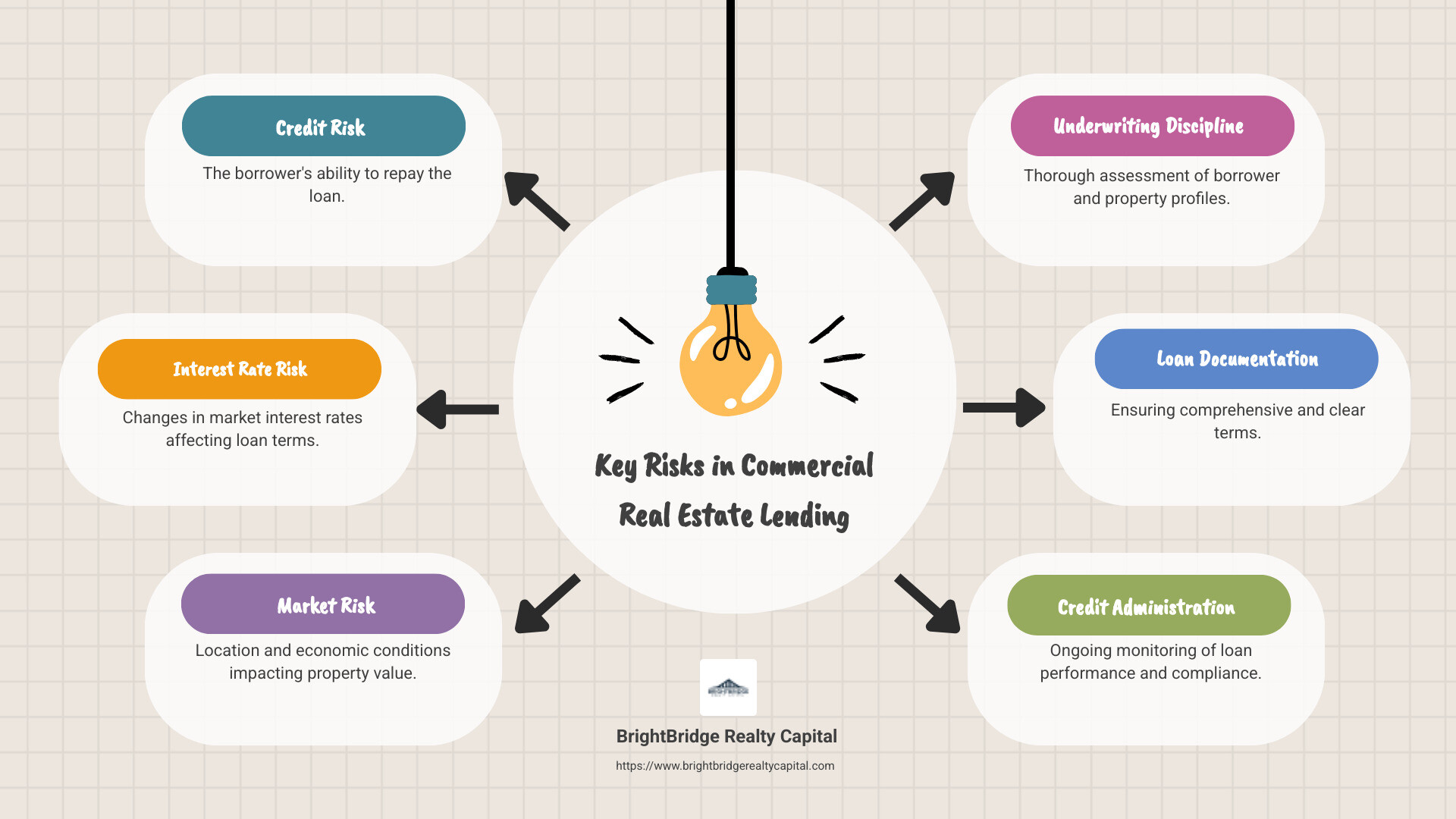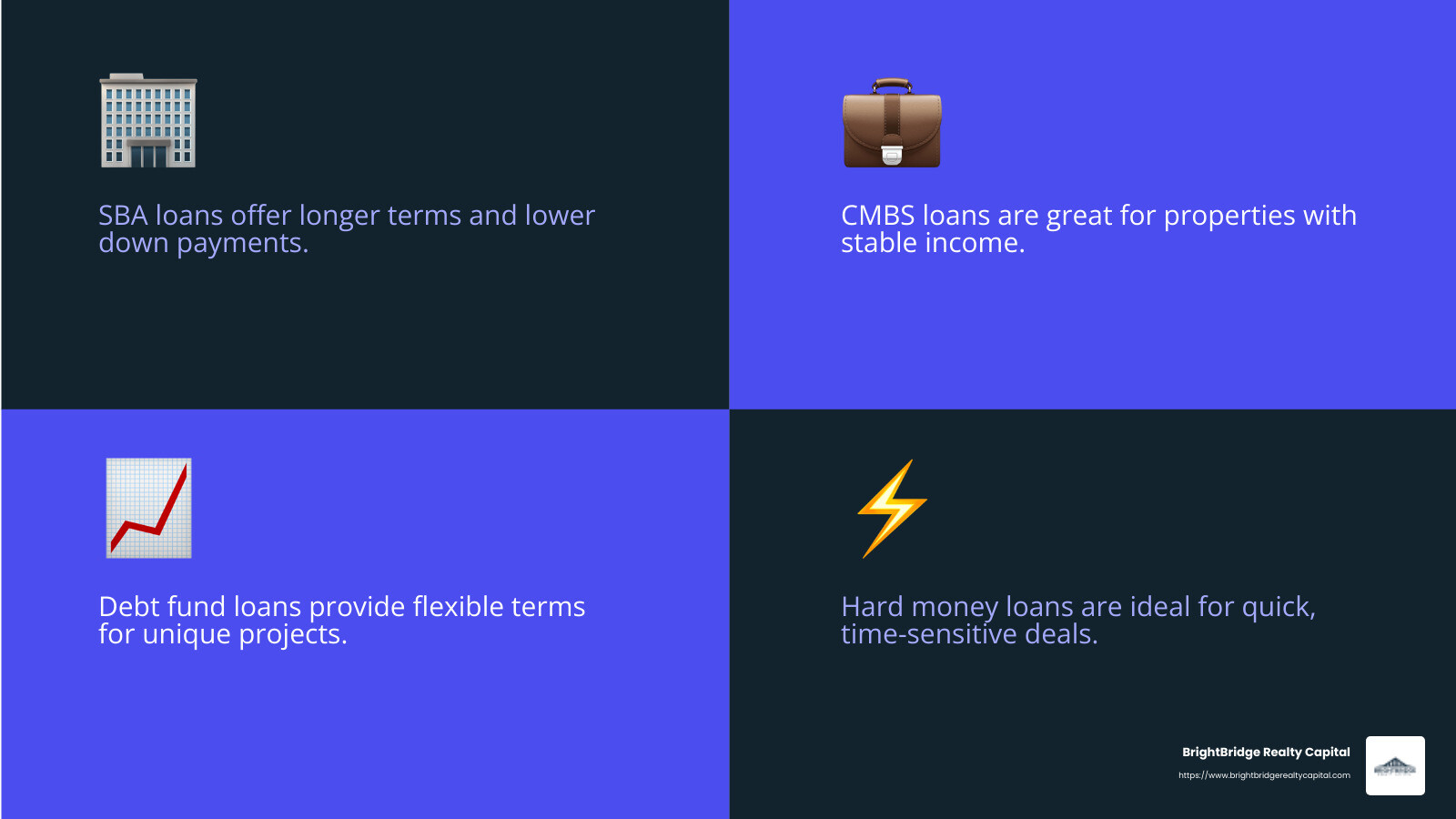Understanding the Risks in Commercial Real Estate Lending

Commercial real estate lending is a crucial component of the real estate industry, providing the financial backbone that supports the development, acquisition, and improvement of income-producing properties. This type of lending differs significantly from residential loans, carrying unique risks and complexities that require careful management. Here’s a snapshot of essential points:
- Purpose: Funding used strictly for business purposes and income generation through properties like offices, retail spaces, and apartments.
- Types of Lenders: Banks, insurance companies, independent lenders, and private debt funds.
- Risks: Credit risk, which involves the borrower's ability to repay; interest rate risk, influenced by fluctuating market rates; and market risk, determined by location and economic conditions.
Effective risk management in commercial real estate lending is a blend of underwriting discipline, thorough loan documentation, and robust credit administration practices. Ensuring that properties generate sufficient rental income to cover debt obligations is key to maintaining loan quality.
Whether you're planning to expand your rental portfolio or invest in commercial developments, understanding these facets of risk management can help you steer the lending landscape successfully.

Key Risks in Commercial Real Estate Lending
When it comes to commercial real estate lending, understanding and managing risks is crucial. Let's explore the three main types of risks you need to be aware of: credit risk, interest rate risk, and market risk.
Credit Risk
Credit risk is all about the borrower's ability to repay the loan. If a borrower struggles financially, they might default on their loan payments, leading to potential losses for the lender.
To mitigate credit risk, lenders often conduct thorough evaluations of a borrower's credit history and financial health. This process is similar to what BrightBridge Realty Capital focuses on by ensuring that borrowers have a strong credit score and reliable income streams. Essentially, lenders need to be confident that the borrower can continue making payments, even in tough economic times.
Interest Rate Risk
Interest rate risk arises from fluctuations in market interest rates. Changes in these rates can significantly affect the cost of borrowing and the value of loans. For instance, if interest rates rise, the cost of borrowing increases, which can strain borrowers who are on variable-rate loans.
Lenders often offer a mix of fixed-rate and variable-rate loans to manage this risk. Fixed-rate loans provide stability, as the interest rate remains constant over the term of the loan. Variable-rate loans, on the other hand, fluctuate with market conditions, which can be advantageous in a declining rate environment but risky when rates rise.
Market Risk
Market risk in commercial real estate lending is influenced by economic conditions and the specific location of the property. Factors like local employment rates, property demand, and economic growth can impact the value and income potential of a property.
For example, a retail space in a booming urban area might be a safer bet than one in a declining rural town. Lenders assess these risks by analyzing market trends and property appraisals to ensure that the property's value will support the loan amount.
In summary, understanding these risks and implementing effective risk management practices can make a big difference in the success of commercial real estate investments. By keeping an eye on creditworthiness, interest rate trends, and market conditions, lenders and borrowers alike can better steer the complexities of commercial real estate lending.
Types of Commercial Real Estate Loans
When it comes to commercial real estate lending, there are several types of loans available. Each serves different needs and comes with its own set of benefits and drawbacks. Let's take a closer look at some of the most common types:
Bank Loans
Bank loans are a traditional and widely-used form of financing in the commercial real estate sector. These loans are typically provided by commercial banks and credit unions. They are often used for purchasing existing buildings, constructing new ones, or renovating properties.
- Pros: Bank loans usually offer competitive interest rates and flexible terms based on the borrower's creditworthiness.
- Cons: They often require a significant down payment and thorough credit checks, which can be a barrier for some borrowers.
SBA Loans
SBA loans are backed by the U.S. Small Business Administration and cater specifically to small businesses. These loans are often used to acquire or refinance owner-occupied commercial properties, such as office buildings and warehouses.
- Pros: SBA loans offer favorable terms, including longer repayment periods and lower down payments.
- Cons: The application process can be lengthy, and these loans cannot be used for multifamily properties.
CMBS Loans
Commercial Mortgage-Backed Securities (CMBS) loans bundle mortgages into securities that are sold to investors. These loans are primarily assessed based on the financial strength of the property rather than the borrower.
- Pros: CMBS loans usually have fixed interest rates and long-term amortization, making them attractive for stable income-generating properties.
- Cons: They can be complex and difficult to obtain in smaller markets.
Debt Fund Loans
Debt fund loans are provided by private investment groups that pool resources to offer financing. These loans are often used for projects that traditional lenders might avoid, such as lease-up financing or property rehabilitation.
- Pros: They offer flexible terms and can be custom to specific project needs.
- Cons: Interest rates are generally higher, reflecting the increased risk.
Hard Money Loans
Hard money loans are short-term financing options, often used for property purchases or renovations when quick funding is needed. These loans focus more on the value of the property than the borrower's credit history.
- Pros: Fast approval and funding make them ideal for time-sensitive deals.
- Cons: They come with higher interest rates and fees, and usually require a larger down payment.

Choosing the right type of loan depends on various factors, including the property's purpose, the borrower's financial situation, and the overall risk tolerance. Understanding these options can help you make informed decisions in commercial real estate lending.
Regulatory and Compliance Considerations
When dealing with commercial real estate lending, it's crucial to understand the regulatory and compliance landscape. These regulations ensure that lending practices are safe, sound, and fair. Let's explore some key aspects:
FDIC Regulations
The Federal Deposit Insurance Corporation (FDIC) plays a vital role in supervising financial institutions. It establishes guidelines to promote stability and public confidence in the financial system. For banks involved in commercial real estate lending, adhering to FDIC regulations is essential. These rules help manage risks and protect depositors.
The FDIC's Interagency Guidelines Establishing Standards for Safety and Soundness, found in Appendix A to Part 364, provide operational and managerial standards. These standards focus on asset quality, asset growth, and overall risk management. They are designed to ensure that banks operate safely and soundly.
Safety and Soundness Standards
Safety and soundness standards are a set of guidelines that financial institutions must follow to maintain their stability. These standards cover various aspects of bank operations, including asset quality and management practices. By adhering to these standards, banks can mitigate risks and prevent financial instability.
A key component of these standards is ensuring that banks have adequate capital and robust risk management practices. As highlighted in the FDIC's Financial Institution Letter, maintaining strong capital levels and appropriate credit loss allowances are critical. Banks are encouraged to conduct stress tests and sensitivity analyses to assess their resilience to economic changes.
Real Estate Lending Standards
Part 365 of the FDIC's regulations outlines real estate lending standards. These standards require banks to adopt and maintain written policies for real estate loans. The policies should address loan-to-value ratios, credit analysis, and collateral evaluation. By doing so, banks can ensure that their lending practices are prudent and align with regulatory expectations.
The Interagency Advisory on Use of Evaluations in Real Estate-Related Financial Transactions provides guidance on when evaluations, rather than formal appraisals, can be used. This flexibility can streamline the loan process while still maintaining accuracy in property valuation.
Understanding these regulatory and compliance requirements is crucial for anyone involved in commercial real estate lending. By adhering to these guidelines, lenders can operate safely and effectively, ensuring the stability of the financial system and the protection of borrowers and depositors alike.
Mitigating Risks in Commercial Real Estate Lending
When it comes to commercial real estate lending, mitigating risks is crucial. Let's explore how disciplined underwriting, effective credit administration, and robust risk management practices can help achieve this.
Underwriting Discipline
Underwriting is the foundation of any lending decision. It's the process where lenders assess the creditworthiness of borrowers and the value of the property. Maintaining underwriting discipline means sticking to strict criteria and not cutting corners.
The Statement on Prudent Risk Management for Commercial Real Estate Lending emphasizes the importance of this discipline. It suggests that by adhering to well-defined underwriting standards, lenders can identify potential risks early. This approach helps in making informed lending decisions, reducing the likelihood of defaults.
Credit Administration
Credit administration involves managing the loan after it's been approved. It's about ensuring that the borrower complies with the loan terms, and the property maintains its value.
The FDIC Advisory on Effective Risk Management Practices for Purchased Loans and Purchased Loan Participations highlights the need for rigorous credit administration. It advises treating purchased loans with the same care as directly originated ones. This means regularly monitoring the borrower's financial health and the property's condition.
A strong credit administration system includes:
- Regular reviews of borrower financials.
- Frequent property inspections to assess condition and market value.
- Timely identification of potential issues, allowing for proactive measures.
Risk Management Practices
Effective risk management is about identifying, measuring, and controlling risks. For commercial real estate lending, this involves assessing market trends, economic conditions, and borrower behavior.
According to the FDIC's Supervisory Insights, banks should maintain strong capital levels and conduct stress tests. These practices help institutions prepare for economic changes and potential downturns.
Moreover, the Managing Commercial Real Estate Concentrations in a Challenging Environment report stresses the importance of diversifying loan portfolios. By not concentrating too heavily in one area, lenders can spread risk and reduce exposure to market fluctuations.
In conclusion, by adhering to underwriting discipline, maintaining a robust credit administration system, and implementing comprehensive risk management practices, lenders can significantly mitigate risks in commercial real estate lending. This approach not only safeguards the lender but also ensures a stable and resilient financial system.
Next, we'll dive into some frequently asked questions about commercial real estate lending to further clarify this complex field.
Frequently Asked Questions about Commercial Real Estate Lending
What are typical terms for commercial real estate loans?
When navigating commercial real estate lending, understanding the typical loan terms is key. Here are some common elements:
Loan-to-Value (LTV) Ratio: This ratio indicates what percentage of the property's value the lender is willing to finance. Typically, LTVs can go up to 75%, and in some cases, like Mezzanine and Preferred Equity, up to 85%. A lower LTV means the borrower needs to put more money down, reducing the lender's risk.
Debt Service Coverage Ratio (DSCR): This measures a property's cash flow against its debt obligations. Lenders usually look for a DSCR of at least 1.25, meaning the property generates 25% more income than the debt payments. A higher DSCR suggests a safer investment for lenders.
How do interest rates affect commercial real estate lending?
Interest rates play a significant role in commercial real estate lending:
Fixed Rates: These rates remain constant throughout the loan term, providing predictability in monthly payments. They're ideal for borrowers who prefer stability and want to avoid fluctuations in their monthly expenses.
Variable Rates: Also known as adjustable rates, these can change over time, often tied to a benchmark like the WSJ Prime Rate. While they might start lower than fixed rates, they can increase, leading to higher payments. This option suits borrowers who anticipate a drop in interest rates or plan to refinance.
What is the role of collateral in commercial real estate loans?
Collateral is a critical component in securing a commercial real estate loan:
Non-Recourse Loans: In these loans, the lender can only claim the property as collateral if the borrower defaults. The borrower's personal assets remain protected. Non-recourse loans are generally favored by borrowers as they limit personal liability.
Recourse Loans: Here, the lender can pursue the borrower's personal assets beyond the property if the loan goes into default. While riskier for the borrower, these loans often come with more competitive terms due to the reduced risk for lenders.
By understanding these terms, borrowers can make informed decisions and select the best loan structure for their needs. Next, we'll explore the regulatory and compliance considerations that play a crucial role in commercial real estate lending.
Conclusion
BrightBridge Realty Capital is here to make your commercial real estate journey smooth and efficient. We understand that every investor's strategy is unique, and that's why we offer customized financing solutions custom to your specific needs.
Our expertise in commercial real estate lending allows us to provide flexible funding options that keep your projects on track. Whether you're flipping properties, building from the ground up, or expanding your rental portfolio, we've got you covered with competitive rates and a seamless process.
One of our key strengths is our ability to close deals fast. We pride ourselves on our fast closings, often within a week, ensuring you can seize opportunities as they arise. As a direct lender, we eliminate the middleman, which means you get the best rates and a hassle-free experience.
At BrightBridge Realty Capital, we are committed to supporting your investment strategy with nationwide lending solutions. Our team of experts is dedicated to managing every detail in-house, from your initial application to your final payoff. This ensures a smooth and seamless experience, guiding you every step of the way.
Ready to move forward with your real estate investment plans? Explore our customized financing solutions and find how we can help you achieve your goals. Let's bridge the gap to your success together.


